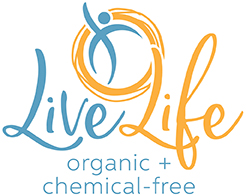Have you had brain fog for weeks? Or months? Or years?
Could you have toxins in your home that are causing your brain fog?
In honor of Brain Awareness Week, we’ll tackle this topic and answer your questions.
What are these brain fog toxins and how can we choose products that don’t cause brain fog?

How the Brain is Effected By Toxins
Studies show that toxins from our everyday products can cause brain fog, but are there other brain-related affects?
Of course! Otherwise, this article wouldn’t exist. 😉
The brain is part of the nervous system. Responsible for controlling body activity, the nervous system is a major organ. It controls and regulates all communications in the body. It affects:
- The Nerves – Impaired ability for messages to pass within the brain and from the brain to the nerves
- The Brain – Memory, thought processes, learning can be hindered. “The nervous system is the major controlling, regulatory, and communicating system in the body. It is the center of all mental activity including thought, learning, and memory.” – National Cancer Institute
- The Spinal Cord – Movement of the muscles and organ function can be affected. “The brain sends messages through the spinal cord and nerves of the peripheral nervous system to control the movement of the muscles and the function of internal organs.” – Eunice Kennedy Shriver National Institute of Child Health and Human Development
When parts of the nervous system are affected, cells in our bodies can’t communicate correctly.
What does that mean for our overall health?
Health Effects Possible
The list of effects is long.
It has to be. The nervous system is critical to how our bodies operate. Therefore, things that affect IT, affect our entire being.
I won’t overwhelm you with a long list, but will mention a few:
| Alzheimer’s disease | behavioral problems | impaired coordination |
| anxiety | nervous system damage | decreased muscle strength |
| attention deficit disorder | short attention span or concentration | difficulty with short term memory |
The Agency for Toxic Substance and Disease Registry, which is part of the U.S. Center for Disease Control, states:
“Possible health effects of the nervous system include inability to move, loss of feeling, confusion, and decreased speech, sight, memory, muscle strength, or coordination.”
Another illness that often results from chemical exposures (acute and long-term exposures) is Multiple Chemical Sensitivity.
Whenever the body senses chemicals, it works hard to protect us from those harmful chemicals. Eventually, it’s fighting all the time.
There is new evidence that shows that the brain can become stuck in “fight or flight” mode, or what’s known as a trauma loop.
Annie Hopper, founder of the Dynamic Neural Retraining System™, created a Limbic System Retraining program that can help people stuck in a trauma loop – from physical exposures (including chemicals in everyday products) and mental exposures – to become unstuck.
Read more on the DNRS™, “What We Treat” page or watch this short video where Annie explains the program.
As part of the overall strategy, she suggests creating a healthy healing environment, with as few chemicals (and electromagnetic frequency) exposures as possible.
In other words, creating an organic, chemical-free household.
The question is not “do I” do it.
It’s “where do I start.”

Where are Brain Fog Toxins Found?
Let’s take a quick look at where these toxic chemicals can be found.
- Food – growing, producing, cooking, storing, packaging, marketing, transporting
- Clothes – materials, dyes, finishes, designs and graphics, notions
- Personal care products – deodorants, soaps, lotions, shampoo and conditioners, make-up, hair sprays, feminine care products
- Cleaners – laundry soap, cleaning supplies, cleaning tools, dish soap
- Appliances – materials, lubricants, finishes
- Building materials – flooring, walls, roofing, siding, cabinets, woodwork and doors, paints and stains, finishes, adhesives
- Furniture – covering, filling, finishes, flame retardants, tables, couches, chairs, mattresses
So, in short, everywhere.
We’re surrounded by these babies.
Pick a spot to start or tackle next. Will you start with food? Cleaners? Clothing?
Choose whatever topic FEELS FUN to start with or tackle next!
Then, follow these simple strategies for creating your best organic, chemical-free household.

6 Simple Ways to Choose Nontoxic Items
1.One Step At A Time. This is #1 for a reason. Sustainable life-long change happens one step at a time. It’s these small, strategic steps that ensure you’ll KEEP choosing nontoxic products!
2. Natural & Organic Clothing. But don’t just look for 100% organic cotton or wool materials. Nontoxic clothing is more than just the material itself. Apply this tip to clothing dyes, finishes, and designs. The easiest way to do that is to look for clothes with a GOTS Organic certification.
3. Certified Bedding. We spend a big chunk of our 24-hours sleeping, 8-9 hours a night (hopefully!). That means we spend many hours surrounded by sheets and blankets. You can buy GOTS Organic certified bedding, or find OEKO-TEX Standard 100 certified bedding. It’s the 2nd strictest textile certification in the world! (Second to GOTS.)
4. Ceramic or glass light fixtures. Every night we turn our lights on and leave them on for hours. When plastic light fixtures, or any plastic for that matter, heats up it off-gasses even more than it does at room-temperature. In high-heat areas, such as lighting, choose shades made of ceramic or glass.
5. Solid Hardwood Furniture. Wood naturally gives off volatile organic compounds (VOCs) that can be just as harmful to health as man-made chemical VOCs. Softwoods have significantly higher amounts of VOCs than hardwoods. Be sure you’re choosing solid hardwood furniture vs. softwood or composite wood furniture, which is made with wood dust, adhesives and resins.
6. Nontoxic Finishes. We must talk about nontoxic finishes when talking about solid wood furniture – the two go hand-in-hand. Solid wood furniture can come unfinished; however, most pieces come with stain and a clear-coat finish on them. Choose bed frames, tables and chairs with finishes that are zero-VOC and free of other harmful chemicals.
Final Thoughts
Clearing up brain fog from toxins in your home can be achieved by creating the best organic, chemical-free household you can.
Pick a place to start, take it one step at a time, and follow our simple strategies. You’ll have a chemical-free household in no time!
Want to learn other simple ways to create the best organic, chemical free household?
